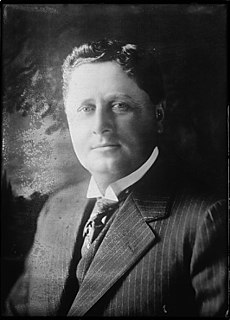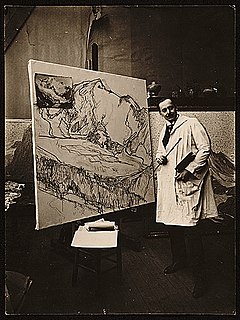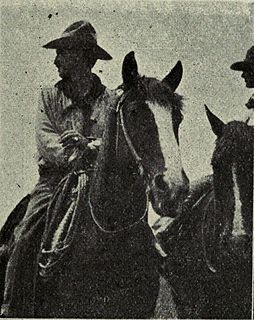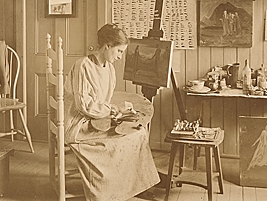Related Research Articles

William Mills Wrigley Jr. was an American chewing gum industrialist. He was founder of the Wm. Wrigley Jr. Company in 1891.

John Henry Waddell was an American sculptor, painter and educator. He had a long career in art education and has many sculptures on public display, but he may be best known for That Which Might Have Been—his memorial to the four girls killed in the 1963 bombing of the 16th Street Baptist Church in Birmingham, Alabama.

Edgar Alwin Payne was an American painter. He was known as a Western landscape painter and muralist.
Luis Alfonso JiménezJr. was an American sculptor of Mexican descent. Known for portraying Hispanic-American themes, his works have been displayed at the Smithsonian and at Denver International Airport.

Joseph Kleitsch was a Hungarian-American portrait and plein air painter who holds a high place in the early California School of Impressionism.
John Mason was an American artist who did experimental work with ceramics. Mason's work focused on exploring the physical properties of clay and its "extreme plasticity". One of a group of artists who had studied under the pioneering ceramicist Peter Voulkos, he created wall reliefs and expressionistic sculptures, often on a monumental scale.

William Penhallow Henderson was an American painter, architect, and furniture designer.

George Elbert Burr was an American printmaker and painter best known for his etchings and drypoints of the desert and mountain regions of the American West.

William Frederic Ritschel, also known as Wilhelm Frederick Ritschel (1864–1949), was a California impressionist painter who was born in Nuremberg, Germany on July 11, 1864.

Colin Campbell Cooper, Jr. was an American Impressionist painter, perhaps most renowned for his architectural paintings, especially of skyscrapers in New York City, Philadelphia, and Chicago. An avid traveler, he was also known for his paintings of European and Asian landmarks, as well as natural landscapes, portraits, florals, and interiors. In addition to being a painter, he was also a teacher and writer. His first wife, Emma Lampert Cooper, was also a highly regarded painter.
William S. Darling was a Hungarian-American art director who was prominent in Hollywood during the 1920s and 30s. Darling received six Academy Award nominations, winning three times. He was inducted into the American Art Directors Guild (ADG) Hall of Fame in 2012. According to the ADG, Darling was one of the "most influential designers in the early days of Hollywood's Golden Age."

The terms California Impressionism and California Plein-Air Painting describe the large movement of 20th century California artists who worked out of doors, directly from nature in California, United States. Their work became popular in the San Francisco Bay Area and Southern California in the first three decades after the turn of the 20th century. Considered to be a regional variation on American Impressionism, the painters of the California Plein-Air School are also described as California Impressionists; the terms are used interchangeably.

Agnes Lawrence Pelton (1881–1961) was a modernist painter who was born in Germany and moved to the United States as a child. She studied art in the United States and Europe. She made portraits of Pueblo Native Americans, desert landscapes and still lifes. Pelton's work evolved through at least three distinct themes: her early "Imaginative Paintings," art of the American Southwest people and landscape, and abstract art that reflected her spiritual beliefs.

Fernand Lungren (1857-1932) was an American painter and illustrator mostly known for his paintings of American South Western landscapes and scenes as well as for New York and European city street scenes.
David Emmett Williams was a Native American painter, who was Kiowa/Tonkawa/Kiowa-Apache from Oklahoma. He studied with Dick West at Bacone College and won numerous national awards for his paintings. He painted in the Flatstyle technique that was taught at Bacone from the 1940s to the 1970s.
Lloyd Henri Kiva New was a pioneer of modern Native American fashion design and a cofounder and president emeritus of the Institute of American Indian Arts (IAIA) in Santa Fe, New Mexico.

Norton Bush was an American landscape painter. He did landscape paintings of California, Panama, Nicaragua, Peru and Ecuador, with a focus on Luminism.
John Hubbard Rich was an American illustrator, painter and art educator. He was the president of the California Art Club from 1944 to 1945.
Randall Davey (1887–1964) was an American painter and art educator. He taught art at several institutions, including the University of New Mexico, and he had his studio in Santa Fe, New Mexico. His artwork can be seen in museums across the U.S..
Clarence Keiser Hinkle was an American painter and art educator. His art studio was in Laguna Beach, California and later in Santa Barbara, California.
References
- 1 2 3 Gerdts, William H.; South, Will (1998). California Impressionism. New York: Abbeville. p. 284. ISBN 9780789201768. OCLC 185809275.
- 1 2 3 4 "William Vincent Cahill". Laguna Art Museum. Retrieved June 9, 2019.
- 1 2 3 "Artist Well Known In Phoenix Dies At Chicago Residence". Arizona Republic. Phoenix, Arizona. August 13, 1924. p. 3. Retrieved June 9, 2019– via Newspapers.com.